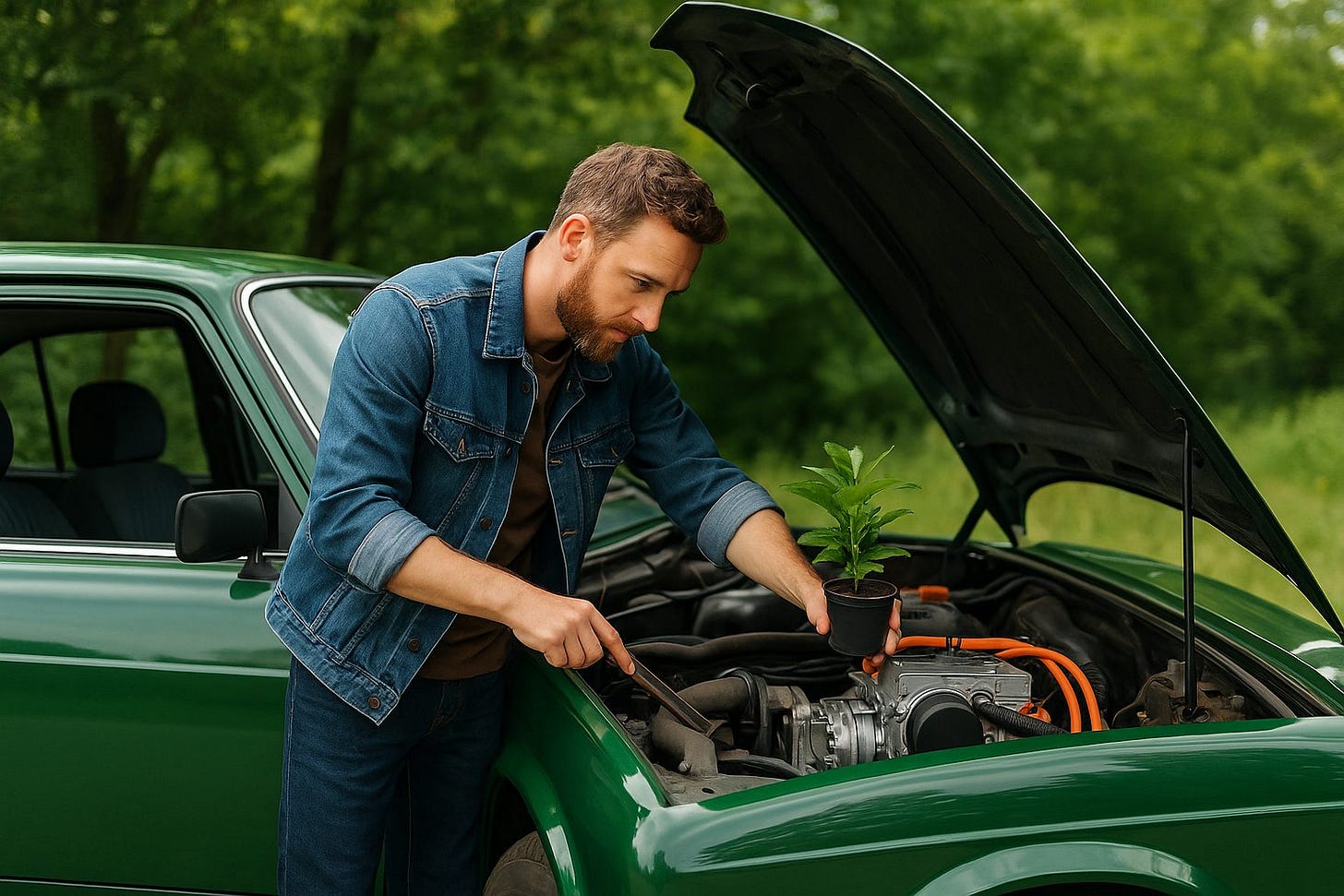5 Ways to Turn Your Old Car into a Greener Ride
Because your four-wheeled friend deserves a second act 🌱
You love your aging car. The patina, the little quirks, maybe even the rattles. But you also worry about its carbon tail—those exhaust fumes, that gas-guzzling fuel economy, the uneasy conscience you feel at every fill-up. What if you could keep your beloved ride but give it a greener lease on life? What if “old car” and “eco-friendly” weren’t mutually exclusive?
In this guide, I’ll walk you through five actionable strategies to reduce your car’s environmental impact—some subtle, some bold, some expensive, some surprisingly accessible. Whether you’re tinkering in your garage or consulting a pro, there’s something here for you. (Spoiler: you might even enjoy the process.)
Let’s roll up our sleeves.
1. Optimize What Already Exists: Tune, Trim, Tweak
Before reinventing the wheel, squeeze every drop of efficiency out of what you already have.
Routine maintenance is magic. A tuned engine, clean filter, proper spark plugs—all reduce inefficiencies. Fixing worn parts can cut emissions by up to 40%.
Tire pressure & wheel alignment matter more than many drivers realize. Underinflated tires make your engine work harder.
Reduce weight where possible. Clean out the junk in your trunk. Remove roof racks when not in use. Every extra kilograms you carry is extra fuel burned.
Drive smarter: ease off on harsh acceleration, brake gently, stick to moderate speeds. Many sources estimate that smooth driving yields 10–20% better fuel economy.
Limit idling & use cruise control on highways. Cutting back idle time is low-hanging fruit.
These changes don’t turn your car into a hybrid or electric machine, but they cost little, are low risk, and maximize what you already have.
2. Switch to Cleaner Fuels or Add-On Hybrid Tech
You don’t always need a full overhaul to gain greener benefits.
Biofuels & biodiesel (where compatible) can reduce net CO₂ emissions, because their carbon “cost” is partially offset by the plant growth cycle.
Plug-in hybrid retrofit kits — like Revolo — let you add electric assist to a conventional engine setup. Revolo claims up to 40% improved fuel efficiency and over 30% less greenhouse gas emissions.
In milder cases, start-stop systems, regenerative braking modules, or mild-hybrid add-ons can reduce waste during city driving.
This approach is a balance: you retain your combustion engine while gaining some of the benefits of electrification—less dramatic, but more attainable for many.
3. Go Full Electromod: Convert to Electric
If you’re ready to go big, convert your car into an EV. Yes—your old faithful can live again as an all-electric ride.
The term electromod (electric + restomod) captures exactly this: restoring and modifying cars with electric drivetrains.
The process typically involves removing the internal combustion engine, exhaust, gas tank, etc., and installing an electric motor, batteries, controller, wiring, and safety systems.
Challenges to navigate:
Weight distribution: batteries are heavy, and the frame must handle the load.
Packaging: finding space for batteries, cooling, wiring, etc.
Supporting systems: you’ll need new brake systems, thermal management, and safety features.
Regulations: you must ensure your conversion meets local safety and emissions (or no-emissions) regulations.
When done right, this path is deeply rewarding: zero tailpipe emissions, lower maintenance (no oil changes, fewer moving parts), and often a smoother, quieter ride.
Conversion costs vary widely—from perhaps tens of thousands to over $100,000 depending on ambition, parts, and labor.
Still, some companies and startups are scaling this model, and retrofitting is seen by many as a key bridge to a lower-carbon future.
4. Offset the Unavoidable: Carbon Credits & Green Programs
Maybe you can’t convert your car. Maybe you don’t want to. You still have options to mitigate.
Carbon offset schemes let you “cancel out” your emissions by supporting reforestation, renewable energy, or conservation projects. Forbes discussed how vintage car owners can leverage such offsets to soften their environmental impact.
Government incentive programs sometimes let you upgrade, replace, or retrofit with subsidies. In the U.S., for example, certain districts offer “Replace Your Ride” incentives, giving thousands to scrap or upgrade polluting vehicles.
Compliance with eco zones: In cities or countries with low-emission zones, converting your car (or documenting low-carbon upgrades) may allow continued access—or avoid penalties.
Offsetting doesn’t fix the emissions, but it gives you a path to balance your carbon “bank account” while you pursue upgrades.
5. Plan Wisely: Use, Share, or Repurpose Your Ride
Sometimes the greenest move is to rethink how much you use your car—and who benefits from every mile.
Car sharing / ride pooling: Lend your car, rent it out, or coordinate with others, so your car’s utility is maximized while emissions per mile decline.
Limit driving when possible: Combine trips, choose efficient routes, use public transport for some errands.
Donate or sell with conditions: If you no longer need the car, pass it on to someone who can make greener use or convert it. The physical structure still has value.
Repurpose components: Even if the car is retired, usable parts like battery modules, electric motors, or seats can live on in projects.
This mindset shift—from car as ownable to car as shared resource—can deliver outsized environmental benefit.
Also read: Hybrid vs Electric Car
Final Thoughts
Turning your old car into a greener ride isn’t just a mechanical project—it’s a statement. It says you believe in transformation, not disposal.
Start small: maintenance, driving habits.
Medium: hybrid kits, fuel tweaks.
Big: full conversion, electrification.
Strategic: offsets, usage redesign.
Every step matters. Maybe you convert partway. Perhaps you never fully electrify. But each upgrade nudges you closer to harmony: your beloved ride, your environmental values.


